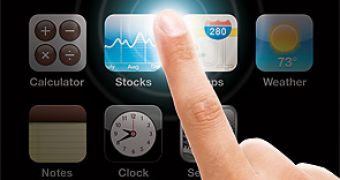There are three ways through which a touch screen display can detect whether or not you are actually touching the display surface and the relative position of the object touching it: the resistive, capacitive or surface acoustic wave system.
The resistive system operates by using a design involving a glass layer on top of which a resistive metallic layer is placed. The two layers are separated by spacers and come in contact only when pressure is applied. Electrical current is pumped through both, thus when a user is touching the screen an electrical contact is closed, modifying the electrical field in the respective spot. The change is picked up by the computer controlling the touch screen, which calculates the exact position where contact was made and the appropriate action that must be carried out.
The capacitive system uses an electrically charged layer placed on top of the glass layer to make an approximate estimation to where contact was made. When the user touches the display, the charge from the conductive layer is drawn towards the user. This triggers a modification of the capacitance of the layer, which is again picked up by the computer and compared to that of the corners of the screen to determine in which position of the screen the user made contact.
As opposed to resistive systems, which radiate only 75 percent of the light generated by the touch screen, capacitive systems transmit up to 90 percent of the electromagnetic radiation, meaning they are able to produce clearer pictures and are therefore more efficient.
The surface acoustic wave systems imply the use of two transducers placed on the vertical and horizontal axes of the display. Acoustical signals are reflected by the glass layer, thus producing a wave that is disturbed when the screen is touched. Because the surface acoustic wave system does not required the use of metallic layers to relay electrical currents, touch screens using this system have maximum light transfer efficiency and produce perfect image clarity.
The three systems also define the kind of material registered while touching the display. The resistive system, for example, relies on closing an electrical circuit and it makes no difference what kind of material interacts with it. The capacitive system however, requires the input of conductive objects such as your finger. Touching it with a plastic object will not trigger any response from the display. Screens using the surface acoustic wave systems work in a fashion similar to that of the resistive one, thus it does not matter what kind of material is used although it is not sensitive to small sharp objects.

 14 DAY TRIAL //
14 DAY TRIAL //